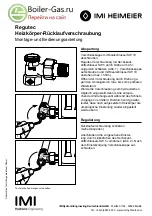
18
INSTALLATION
C13
C13
C13
C53
C63
C33
C43
B23
B23P
B53P
C93
C83
B23
Upstream fan. Comburent air intake directly from the
room where the boiler is installed. Flue gas venting via
horizontal or vertical pipes, with air ventilation to room.
B23P
As B23 but with flue gas vent pipes designed to operate
at positive pressure.
B53P
As for B23P but with flue gas vent pipes supplied by
boiler manufacturer.
C13
Concentric wall vent. Twin flue pipes can also be used,
but the wall through-pipes must be concentric or
located close enough to be subjected to similar wind
conditions.
C33
Concentric roof vent. Twin flue gas vent pipes may be
used, but terminals must be concentric or near enough
to be subject to the same wind conditions (i.e. within a
100 cm square with a difference in height between the
pipes of less than 100 cm).
C43
Vent and air intake via separate twin pipes subject to
similar wind conditions.
C53
Separate wall or roof vent and air intake, in areas of
different pressure but never on opposite walls.
C63
Upstream fan. Boiler intended to be connected to a
system for the supply of combustion air and for the
evacuation of combustion products approved and sold
separately.
C83
Separate vent and inlet subject to natural draught. Wall
air inlet.
Vent to individual or shared chimney. Shared chimneys
must be insulated to prevent the formation of
condensation.
C93
Fan in combustion circuit upstream from the
combustion chamber/heat exchanger.
This configuration is used in older system upgrades
and with condensing boilers. It allows the system to
make use of an old air well, chimney or flue that would
otherwise be redundant.
9
See the specific standard for details. In Belgium, see
NBN-D51-003.
9
For B-type installation, combustion air is taken from the
environment and goes through the openings (shutters) on
the rear panel of the device that must be located in a suita-
ble and ventilated technical room.
9
Read the requirements, instructions and prohibitions de-
tailed below carefully, since non-compliance with them
may be result in a safety hazard or the appliance's malfunc-
tion.
9
Condensation appliances described in this handbook must
be installed with flue gas pipes compliant with applicable
legislation and expressly manufactured for this specific use.
9
Check that pipes and joints are not damaged.
9
Joint seals must be executed with materials that withstand
the condensate's acidity and the temperatures of the appli-
ance's flue gases.
9
When installing flue pipes, always bear in mind the direc-
tion of the flue gases and of possible condensate flows.
9
Inadequate or incorrectly sized flue gas pipes may increase
combustion noise, create condensate extraction issues and
negatively impact on combustion parameters.
9
Check that pipes are suitably far (min. 500 mm) from flam-
mable or heat-sensitive construction elements.
9
Do not connect the vent flue directly to existing flues used
to serve other appliances (cookers, other boilers, etc.). Larg-
er disused flues can nevertheless be used as ducts for rout-
ing the boiler's intake and vent flues.
9
If the vertical section of vent flue is over 4 metres in height,
a condensate drain must be provided at its bottom (see par-
agraph "Preparation for the condensate drain“).
0
It is prohibited to block or section the flue gas extraction
pipe or the combustion air suction pipe, if any.
0
It is prohibited to use pipes that not designed for this ap-
plication, because the condensate's action would damage
them quickly.
Содержание TAU Unit 100
Страница 1: ...cod 20144127 rev 8 01 2021 TAU Unit 50 70 100 115 EN INSTALLATION AND MAINTENANCE MANUAL...
Страница 137: ...137 SYSTEM MANAGER...
Страница 138: ...138 SYSTEM MANAGER...
Страница 139: ...139 SYSTEM MANAGER...
















































